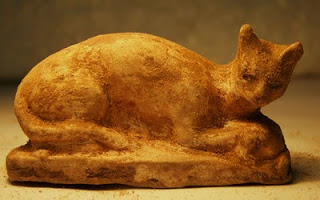Egypt
drhawass.com
Press Release. With photos.
- Earliest Ever Civil Roman Basilica Found Outside Alexandria
Ahram Online (Nevine El-Aref) With three photos. At Al-Baron area in Semouha district, south of Alexandria, an Egyptian archaeological mission has discovered several significant monuments and artefacts that will help in the writing of the history of the...
- Labib Habachi Discovery Of Statue Of Amenhotep Iii Rediscovered In Luxor
drhawass.com (Zahi Hawass) Press Release. I'm glad that there was a good mention of Labib Habachi in this report. Labib Habachi was a remarkable man, and Egyptian archaeologist from the wrong side, at the time of his graduation, of Egyptian elitist...
- Another Statue Uncoverd At The Temple Of Amenhotep Iii, Luxor
drhawass.com Press Release. The upper portion of a red granite double statue featuring King Amenhotep III (1390-1352 BC) with the falcon-headed sun god Re-Horakhti was found today on the north western side of Amenhotep III’s funerary temple on Luxor’s...
- Recent Excavations And Restoration In Beni Suef
drhawass.com (Zahi Hawass) With photo. As part of the Ministry of Culture’s initiative to refurbish and develop museums around Egypt, the Supreme Council of Antiquities (SCA) is reorganizing the layout of the Beni-Suef museum in Upper Egypt. Cultural...
- New Temple Found
A Ptolemaic temple has been found at Kom el Dikka area in Alexandria, the temple was discovered along with hundreds of statues. The temple is dedicated by queen Berenike wife of king Ptolemy III (246-222 bc). ...
Egypt
In the field: Temple of Berenike discovered at Kom el Dikka
drhawass.com
Press Release. With photos.
An archaeological mission of the Supreme Council of Antiquities (SCA) led by Dr. Mohamed Abdel Maqsoud, Head of Antiquities of Lower Egypt, discovered the remains of a temple of Queen Berenike, the wife of king Ptolemy III (246-222 BC), along with a cachette of 600 Ptolemaic statues.
The discovery was made during routine excavations at the Kom el Dikka area in Alexandria, in an area that belongs to Alexandria Security Forces.
Dr. Zahi Hawass, Secretary General of the SCA, said that the discovered remains are 60 meters tall and 15 meters in width and extend under Ismail Fahmy street. He explained that the temple was subjected to destruction during later eras when it was used as a quarry, which led to the disappearance of many of its stone blocks.
Dr. Abdel Maqsoud said that the mission, which includes 18 skilled excavators and restorers, unearthed a large collection of statues depicting the cat goddess Bastet, the goddess of protection and motherhood, which indicates that the temple was dedicated to this goddess.
Dr. Maqsoud pointed out that the Bastet statues were unearthed in three different areas of the site along with other limestone statues of unidentified children and women. Clay pots as well as bronze and faience statues of different ancient Egyptian deities have been also uncovered, along with terracotta statues of the gods Harpocrates and Ptah.
Early studies on site revealed that the temple’s foundation can be dated to the reign of Queen Berenike, making this the first Ptolemaic temple discovered in Alexandria to be dedicated to the goddess Bastet. It also indicates that the worship of the goddess Bastet continued in Egypt after the decline of the ancient Egyptian era.
An inscribed base of a granite statue from the reign of King Ptolemy IV (205-222 BC) was also unearthed. It bears ancient Greek text written in nine lines stating that the statue belonged to a top official in the Ptolemaic court. Dr. Maqsoud believes the base was made to celebrate Egypt’s victory over the Greeks during the Battle of Raphia in 217 BC.
The mission also found a group of old structures, including a Roman water cistern, a group of 14 meter-deep water wells, stone water channels, and the remains of a bath area, well as a large number of clay pots and sherds that can be dated to the fourth century BC.
Abdel Maqsoud believes that this find is the first trace of the real location of Alexandria’s royal quarter.
- Earliest Ever Civil Roman Basilica Found Outside Alexandria
Ahram Online (Nevine El-Aref) With three photos. At Al-Baron area in Semouha district, south of Alexandria, an Egyptian archaeological mission has discovered several significant monuments and artefacts that will help in the writing of the history of the...
- Labib Habachi Discovery Of Statue Of Amenhotep Iii Rediscovered In Luxor
drhawass.com (Zahi Hawass) Press Release. I'm glad that there was a good mention of Labib Habachi in this report. Labib Habachi was a remarkable man, and Egyptian archaeologist from the wrong side, at the time of his graduation, of Egyptian elitist...
- Another Statue Uncoverd At The Temple Of Amenhotep Iii, Luxor
drhawass.com Press Release. The upper portion of a red granite double statue featuring King Amenhotep III (1390-1352 BC) with the falcon-headed sun god Re-Horakhti was found today on the north western side of Amenhotep III’s funerary temple on Luxor’s...
- Recent Excavations And Restoration In Beni Suef
drhawass.com (Zahi Hawass) With photo. As part of the Ministry of Culture’s initiative to refurbish and develop museums around Egypt, the Supreme Council of Antiquities (SCA) is reorganizing the layout of the Beni-Suef museum in Upper Egypt. Cultural...
- New Temple Found
A Ptolemaic temple has been found at Kom el Dikka area in Alexandria, the temple was discovered along with hundreds of statues. The temple is dedicated by queen Berenike wife of king Ptolemy III (246-222 bc). ...

